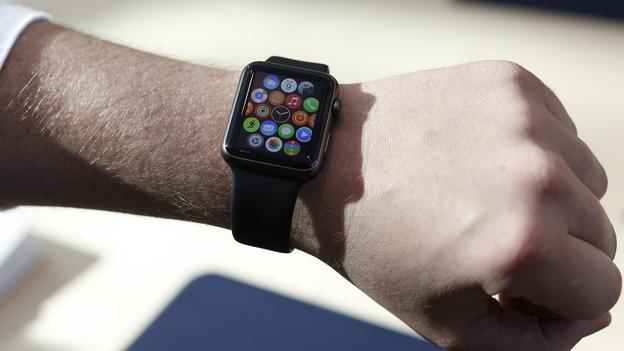As the Apple Watch launches amid much hype, BBC Culture asks experts for their favourite designs of the last 100 years. Can the new timepiece compete?
You know something is going to be talked about when it’s made of gold and worn by Beyoncé. And as with any other Apple product, the brand’s new smartwatch is not short of hype. According to CEO Tim Cook, the Apple Watch "will redefine what people expect from a watch”.
"The Apple Watch could be a turning point not just in wrist watches but in wearable technology,” says the editor of watch-enthusiast website Hodinkee (and ‘the high priest of horology’), Benjamin Clymer. "It’s the first piece of mass adapted wearable technology ever. For Google Glass, the functionality wasn’t there (it simply didn’t do what it was supposed to do), it wasn’t attractive as a design object, and it actually had a negative impact on the perception of its wearer, which is all counter to what the Apple Watch will do.”
Yet it can’t escape the fact it is, for all intents and purposes, still a watch. While it can’t compete with a $50,000 (£33,000) timepiece, it is, as Clymer argues, "competing for the same real estate on your wrist, so it will impact the lower end of the watch industry”. Martin Haussermann, the editor of 1001 Wristwatches, agrees. "The Apple Watch won’t affect the luxury watches market – it will affect the quartz market.”
Some argue it will go further than that. "It has the merit of stirring up a hornet’s nest in the Swiss watch industry,” says Régis Huguenin, chief curator of the International Museum of Horology in Switzerland. So what are the timepieces that did the same in the years they were launched? BBC Culture finds the wristwatches that marked turning points when they first appeared – with endorsements from aviation pioneers, deep sea explorers and astronauts.
The first pilot’s watch: Cartier Santos Dumont (1904 – first on sale 1911)
According to Guinness World Records, the first wristwatch was designed by Patek Philippe for the Countess Koscowicz of Hungary in 1868. Yet for decades it was worn only by women as a ‘montre bracelet’. While wristwatches gained widespread adoption by men after World War I, there were a few pioneers at the beginning of the 20th Century. "Pilots need a watch on their wrist for navigation – and the first pilot’s watch existed before World War I,” says Haussermann.
"Louis Cartier took a pocket watch and made it a wrist watch for a friend who was flying a plane in Paris, one of the earliest pilots.” Brazilian aviation pioneer Alberto Santos-Dumont was the first to demonstrate that controlled flight was possible – and he wanted to measure time intervals while keeping both hands on the controls.
According to Haussermann, Cartier’s watch had a contrasting dial "big enough that he could read the time at the first glance – this is what you ask for when you want a pilot’s watch, readability”. Santos-Dumont wore it every time he flew.
The first commercial wristwatch: Cartier’s Tank (1919)
It’s one of the most coveted wristwatches ever, worn by Greta Garbo, Cary Grant, Princess Diana, Jackie Kennedy, Grace Kelly and Andy Warhol. And its creator claimed to have been inspired by a tank. Arguably one of the first wristwatches that wasn’t just a pocket watch on a strap, the Tank incorporated the geometry of Art Deco and brought the face and the band together in a seamless design.
"Watchmakers were not really concerned with style,” Sam Hines, head of the watch department at Christie’s in New York, told Vanity Fair in 2009. "Yes, you did get many beautifully designed pocket watches, but the pocket watch is kept in the pocket. Their concerns were: How is the watch running? How is it performing in this test or that exhibition? Cartier, being a jeweller, had an advantage because he was concerned with the design, how it would look on one’s wrist.”
The first waterproof watch: Rolex Oyster (1926)
With a hermetically sealed case, the Oyster cemented its reputation as the first waterproof watch when 24-year-old Mercedes Gleitze wore it during her 10-hour swim across the English Channel in 1927 – and it reached Dover in perfect working order. Gleitze wrote to Rolex: "You will like to hear that the Rolex Oyster watch I carried on my Channel swim proved itself a reliable and accurate timekeeping companion even though it was subjected to complete immersion for hours in sea water at a temp of not more than 58 and often as low as 51.”
The Oyster was the predecessor to the Submariner, a classic watch worn by Che Guevara and Sean Connery as James Bond. "Early Rolex watches played such an important role in the history of wrist-bound technology. They really brought the idea of accurate, self-winding, waterproof watches into reality,” says Clymer.
The watchmaker isn’t afraid of a challenge. "In 1960 a special Rolex Oyster was submerged 10,916 metres in the Mariana Trench with Auguste Piccard,” says Huguenin. It survived the enormous pressure intact. "They keep this name today – any Rolex waterproof watch is called Oyster,” says Haussermann.
The first sports watch: Jaeger-LeCoultre Reverso (1931)
With a reversible case and a slide-and-flip mechanism that allowed the dial to be protected, the Reverso was one of the first wristwatches designed for sports. "In the normal position, the time can be read the time but a special mechanism means it can be turned upside down,” says Haussermann. "It was worn by polo players so the glass couldn’t be damaged during a match – it has a steel backside that can withstand knocks.” With its square face, the watch established itself as an Art Deco classic before circular dials gained in popularity during World War II.
The watch that changed fashion: Panerai Luminor (1950)
According to Haussermann, the Luminor was initially "built as a diver’s watch for the Italian navy but in recent times it made bulky watches popular, even for women. It’s 45mm in diameter – until then gents watches were 37 to 38mm in diameter – that’s quite a difference, especially when you see it on somebody’s wrist. And a lot of ladies wear it.”
The watch that went to the moon: Omega Speedmaster Professional (1957)
So accurate, it has been credited with helping to save the Apollo 13 astronauts, the Omega Speedmaster even made it onto the first moonwalk. While Neil Armstrong left his Speedmaster in the Lunar Module as back-up because of a malfunctioning timer, Buzz Aldrin made sure he wore his as he stepped onto the moon’s surface. "Few things are less necessary when walking around on the moon than knowing what time it is in Houston, Texas,” said Aldrin in his memoir Return to Earth. "Nonetheless, being a watch guy, I decided to strap the Speedmaster onto my right wrist around the outside of my bulky spacesuit.”
The Speedmaster had to pass a series of stringent tests before it was approved by Nasa, including temperature fluctuations between -160° and +120°C. It is still worn today by astronauts on shuttle missions. "The Speedmaster has become the archetype for sport watches and chronographs,” says Clymer.
The original steel watches: Audemars Piguet's Royal Oak (1970), IWC’s Ingenieur (1976) and Patek Philippe's Nautilus (1976)
The first luxury watches in steel were all designed by Gérald Genta – the Patek Philippe Nautilus, the Royal Oak for Audemars Piguet and IWC’s Ingenieur,” says Haussermann. "Those three watches are like siblings, they brought steel into the luxury market and a modern design into wristwatches. Before then, it was only gold – and then steel was seen as a luxury material; those watches are no cheaper than gold ones.”
The ancestor of the smartwatch: Hewlett-Packard HP-01 (1977)
When the HP-01 was introduced in 1977, Hewlett-Packard boasted: "You can do anything from viewing the time to dynamically calculating the cost of a long distance phone call or, if a pilot, finding the distance to your next checkpoint.” The watch combined functions, allowing the user to change time zones by adding or subtracting hours and minutes in the calculator.
"This was the first quartz watch with an LED display, wristwatch and a calculator,” says Huguenin. "It was the ancestor of smartwatches.”
Clymer mentions Seiko and Casio G Shock. "Smartwatches have been around for a long time – multifunctional digital watches have existed since the 1970s.”
The new Swiss watch: Swatch (1983)
According to Huguenin, the Swatch was a "completely new concept of Swiss watch, designed with success. It also meant the end of the quartz crisis of the 1980s in Switzerland.”
Clymer agrees. "The Swatch revived the Swiss watch industry by making watches fun, cheap, and cool again.” He acknowledges that, while the Apple Watch will largely affect the cheaper end of the industry, it still has the potential to shake up watch design. "Watches don’t have to be expensive to be very important. The most important watch of the last 30 years is the Swatch.”
And Swatch doesn’t intend to take the challenge without a fight. Swatch Group CEO Nick Hayek has said that their smartwatches "will always be first beautiful watches… and no need to recharge every day – nor every month”.
(BBC)
www.ann.az
Follow us !











